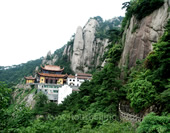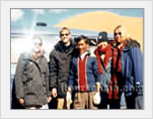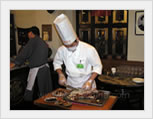
Mt. Jiuhua Guide
-Travel to Mt. Jiuhua Travel to Mt. Jiuhua, you can get to know the great power and beauty of the nature, as well as the strong atmosphere of Buddism. Mt. Jiuhua was called Mt. Lingyang in Han Dynasty. It was called Mt. Jiuzi in Liang and Chen Dynasties of South Dynasties. A legend says that the great poet Li Bai of Tang Dynasty traveled here and wrote down a poem and the mountain got the name from it. In 719 AD, Kim Qiaoque, prince of the King of Xinluo came to Jiuhua Mountain and cultivated himself for 5 years. After he died at 99 years of age, his corporeal body stayed intact. Because he was very similar in
Travel to Mt. Jiuhua, you can get to know the great power and beauty of the nature, as well as the strong atmosphere of Buddism. Mt. Jiuhua was called Mt. Lingyang in Han Dynasty. It was called Mt. Jiuzi in Liang and Chen Dynasties of South Dynasties. A legend says that the great poet Li Bai of Tang Dynasty traveled here and wrote down a poem and the mountain got the name from it. In 719 AD, Kim Qiaoque, prince of the King of Xinluo came to Jiuhua Mountain and cultivated himself for 5 years. After he died at 99 years of age, his corporeal body stayed intact. Because he was very similar in
 appearance to Dizang Buddhisattva, the Mountain became the place to hold rites for Dizang Bodhisattva. Mt. Jiuhua, one of the four great Buddhist Mountains in China (together with Wutai Mountain in Shanxi, E’mei Mountain in Sichuan, Putuo Mountain in Zhejiang), is delicately beautiful which is located in the southeastern part of Chizhou City, Anhui Province. The gross area reaches 120 square kilometers, while the protection area reaches 114 square kilometers. During the golden periods of the Ming and Qing Dynasties, there were as many as 360 temples and 4,000 to 5,000
appearance to Dizang Buddhisattva, the Mountain became the place to hold rites for Dizang Bodhisattva. Mt. Jiuhua, one of the four great Buddhist Mountains in China (together with Wutai Mountain in Shanxi, E’mei Mountain in Sichuan, Putuo Mountain in Zhejiang), is delicately beautiful which is located in the southeastern part of Chizhou City, Anhui Province. The gross area reaches 120 square kilometers, while the protection area reaches 114 square kilometers. During the golden periods of the Ming and Qing Dynasties, there were as many as 360 temples and 4,000 to 5,000
monks and nuns. Mount Jiuhua was originally known as Jiuzi (Nine-Peak) Mountain. Precious sutras and other cultural relics in the temples are displayed in the Historical Relics Museum of the Jiuhua Mountain. The most valuable are the Buddhist canonical literature left from the Tang Dynasty, the Tripitaka left from the Ming Dynasty, and Emperor Kang Xi and Emperor Qian Long's handwritings left from the Qing Dynasty. Here's some guide information in your travel of Mt. Jiuhua: Address: Mt. Jiuhua Tourism Area, Anhui Province. Contact number: 0086-0566-5013450 Admission Fee: CNY200 Opening Hours: 08:10 to 18:00
More Attractions in Hefei
Your Question & Quick Answer*We welcome and appreciate your questions & reviews
Booking Procedures | Terms & Conditions | Payment Methods | Links | Site Map | About Us | Contact Us | Travel Agent
Copyright 2008, All rights reserved.. itourbeijing.com professional china travel guide and china travel service
TEL: 86-10-85711972 (Universal) 1-888-288-9328 (North America) E-mail: contact@itourbeijng.com
Tours Index | China Tours | Beijing Tours | Xi'an Tours | Shanghai Tours | Guilin Tours | Tibet Tours
China Travel | Beijing Travel | Shanghai Travel | Xi'an Travel | Guilin Travel |Beijing Map
China Golf | Beijing Golf | Shanghai Golf | Xiamen Golf | The Great Wall Travel | Yangtze Cruise | Travel Picture



